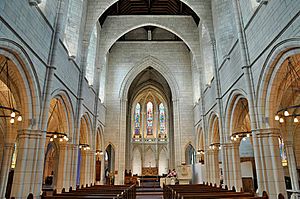St Matthew's, Auckland facts for kids
Quick facts for kids St Matthew-in-the-City |
|
|---|---|
| St Matthew's-in-the-City Church | |
| St Matthew's | |

St Matthew-in-the-City as seen from the northwest
|
|
| 36°51′01″S 174°45′40″E / 36.8502°S 174.7611°E | |
| Country | New Zealand |
| Denomination | Anglican |
| History | |
| Status | Church |
| Founded | 23 April 1902 |
| Founder(s) | Governor Lord Ranfurly |
| Dedication | Saint Matthew |
| Architecture | |
| Functional status | Active |
| Architect(s) |
|
| Architectural type | Church |
| Style | Gothic Revival |
| Years built | 1902 – 1905 |
| Specifications | |
| Capacity | 1,400 people |
| Materials | Oamaru stone |
| Bells | 8 |
| Administration | |
| Parish | St Matthew-in-the-City |
| Diocese | Auckland |
| Province | Anglican Church in Aotearoa, New Zealand and Polynesia |
St Matthew's-in-the-City Church, often called St Matthew's, is an old Anglican church in Auckland, New Zealand. It's located at 132-134 Hobson Street in the city center. This church is part of the Anglican Church in Aotearoa, New Zealand and Polynesia. It was finished in 1905 and is famous for its Gothic Revival style, which looks like old European cathedrals.
History of St Matthew's Church
As Auckland grew, many homes and shops appeared west of Queen Street. To serve the Anglican people living there, George Selwyn, New Zealand's first Anglican bishop, got some land in 1843. This land was at the corner of Hobson and Wellesley Street.
A small school building was built on this land. Bishop Selwyn held the first church services in this school room.
In 1855, Reverend Frederick Thatcher became the vicar (leader) of the new St Matthew's parish. He had also designed Old St Paul's, Wellington. On July 13, 30 people met in the school room to officially start the new church community.
St Matthew's became the church for merchants and shopkeepers in the growing western part of Auckland. The church community grew strong and was able to support itself financially within 10 years.
As Auckland continued to expand, new church communities were formed. St Matthew's even built a smaller mission chapel, St Thomas', in Freemans Bay in 1876.
In 1896, the church decided it was time to build a larger stone church. They hired John Loughborough Pearson, a famous architect who designed Truro Cathedral in England. Sadly, he passed away in 1897 before finishing the plans. His son, Frank Loughborough Pearson, completed his father's work. The first stone for the new church was laid on April 23, 1902, by Governor Lord Ranfurly.
The Church's Role in the Community
As central Auckland became more focused on businesses, fewer people lived in the church's immediate area. St Matthew's then took on a bigger role in the city's public life. Because of its size, location, and beautiful style, it became a popular place for important city events.
For example, the church held a special service for Prime Minister Richard Seddon after he passed away. It also hosted a celebration for King George V's 25th year as king in 1935. During the two World Wars, St Matthew's held services to say goodbye to soldiers and to give thanks when they returned home. In more recent times, the church has held memorial services for victims of the Air New Zealand Flight 901 disaster on Mount Erebus.
St Matthew's has always been involved in helping people and promoting fairness. This is called "social justice." The church was a strong voice against apartheid (unfair rules based on race) in South Africa during the 1981 Springbok rugby tour. In 1996, Nelson Mandela, a leader who fought against apartheid, visited St Matthew's. He came to thank New Zealand for its important role in ending those unfair rules. Today, St Matthew's continues to help people who are struggling and works to achieve the UN Millennium Development Goals. These goals aim to end extreme poverty around the world.
In 2013, Reverend Helen Jacobi became the vicar of St Matthew's. She was the first woman to hold this position at the church.
The church building has a special stone that is 1300 years old. It came from the ruins of St Augustine's Abbey in England. St Matthew's is listed as a Category I Historic Place, meaning it's a very important historical site. It also has 8 bells, most of which were made in 1862. These bells are rung in a special style called "change ringing" by members of The Australian and New Zealand Association of Bellringers.


